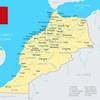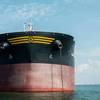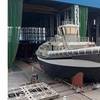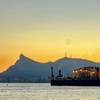Interview: Jennifer Carpenter, AWO
Jennifer Carpenter has been president and CEO of The American Waterways Operators (AWO) in January 2020, but her time with the national trade association representing the inland and coastal tugboat, towboat and barge industry dates back to 1990. This month, she weighs in on top challenges and opportunities currently present in the industry, from difficult regulatory changes to the uptake of cleaner vessel technologies.
What are some of the biggest and most important issues facing the tug, towboat and barge industry?
Big picture, I feel like our industry has never been more relevant. Just think of everything that's going on in the country and in the world. We are in the thick of it. From security concerns. Our industry is just essential to national and homeland security. Sustainability. Our industry is the most fuel efficient, the most environmentally friendly way to move bulk commodities. Jobs, workforce, career development, diversity and inclusion. We have got tremendous jobs and really ladders of career opportunity on offer in this industry that are available to people who live anywhere in the country because you don't have to live where you work when you work on a vessel. So all of that is to say, I feel like our industry is just in the right place at the right time.
How do we keep it that way? Foundationally, we need continuing rock-solid support for the Jones Act. We need continuing investments in waterways infrastructure that enable us to keep moving commerce safely and efficiently and sustainably. Moving efficiently reduces idling and fuel usage, so it's totally part of the sustainability mix. We've got to keep our eye on the workforce development issues because I mentioned we've got these tremendous opportunities to offer, but if people don't know that our industry exists, then we've got a problem and we do have problems. We've got to cast a much wider net. We also need to work to make sure that there aren't barriers to people advancing through the industry. So those are things that I would highlight.
One of the issues that you mentioned is the Jones Act, and there are still some question marks around that in U.S. offshore wind. What does AWO hope to see on this front as the industry continues to build?
I would start by saying there is way more that is settled here with respect to Jones Act applicability than there is not, because two years ago in the National Defense Authorization Act, Congress included a clarification to the Outer Continental Shelf Lands Act that said, U.S. laws, that includes the Jones Act, apply to renewable energy development on the outer continental shelf. So, what that means is, any kind of transportation between two points is going to be subject to the Jones Act.
So, what are AWOs expectations? Minimal expectation is that folks are going to comply with the law, and I do expect that. If there are any attempts to skirt the law, then we've got Customs and Border Protection, Jones Act Division of Enforcement, we've got the Coast Guard there to ensure that doesn't happen.
Beyond that, we are just excited about the opportunity that offshore wind provides. I've said this before, it is the biggest new market for the domestic maritime industry in a generation. There is huge opportunity, and we want to maximize that. Most of the vessels that are going to be needed to build out offshore wind in the U.S. are going to have to be Jones Act qualified, where there are things that are not considered transportation, they are industrial applications and they can be done with foreign vessels. We want to maximize the use of American vessels where they exist.
A third thing, not really Jones Act related, but just in terms of expectations and hopes related to offshore wind, there's a lot going on in the ocean as you know, and there's an increasing amount. So we are strongly supportive of proactive collaboration and communication, both between federal agencies who own different pieces of the puzzle here. BOEM, which is doing the leasing, the Bureau of Ocean Energy Management. The Coast Guard, which is regulating navigation, safety. Wind developers, the industry. We need to work together so that we can maintain safe shipping lanes, safe transportation, even if there is more stuff out there in the ocean. We don't think this is a binary choice. You can have one, but you can't the other? No, we can have both. We just need to do some good, sound planning. We are encouraged that there is increasing recognition of that, but we need to keep it going.
Earlier you mentioned the fact that marine is the most sustainable form of transport for bulk commodities, but still we're seeing a lot of efforts across the industry to clean up even further with companies implementing or in some cases starting to explore new technologies to reduce their environmental footprint. From your point of view, do you think the industry needs to do more to accelerate these efforts? What can and should be done, and where do you see the greatest opportunities?
Yeah, I think there is tremendous opportunity here. It was really, really gratifying to see in the Biden Administration's transportation decarbonization blueprint, that they recognized that moving more cargo by water is really part of the answer to decarbonizing, improving the sustainability of the transportation system generally. So at AWO, we're looking at this at three levels.
Step one, let's maximize the amount of cargo we move by water because that is way more efficient than doing it by rail or truck. Two, let's make sure that we are moving things by water in as sustainable way as possible. So that gets to some of the infrastructure investments that I'm talking about. Let's not have long queues at locks where we're waiting to go through and we're burning fuel while we wait. Those kinds of efficiency improvements are really helpful. Then third, at the individual vessel owner level, we want to make sure that we have policies, we have resources that are supporting companies in improving their environmental footprint, no matter their business drivers.
When you look at early adopters, when you look at some of the really cool, new technology that is being rolled out now, whether that is Crowley's eWolf, the electric tug that's going to be working in Southern California or the ACBL-Maritime Partners Hydrogen One methanol to hydrogen on the Inland River System, other hybrid engine technology. We want to make sure that Coast Guard policies are nimbly adapted and they are not standing in the way of progress here. We want to support and encourage those early adopters because the whole industry is going to be able to learn from their leadership, and that's going to facilitate broader adoption of these technologies.
At the same time, vessels in our industry are long-lived assets. That is not a bad thing environmentally, that's actually a really good thing environmentally. This is not fast fashion for vessels. These things are built to last. So, what can be done and what companies are doing is looking to repower and upgrade existing engines. You can dramatically reduce the carbon footprint, the fuel usage of a diesel engine by going from a Tier 0 or 1 to a Tier 3 engine. Tier 4 generally is something you do with a new vessel because you're kind of building the engine room around that. There is so much that can be done to improve the sustainability of existing vessels through repowers.
How can we support that? I was just down in Houston with AWO members for our Midwest Ohio Valley and Southern region this week, and people were taking serious notes as a representative from the Texas Council on Environmental Quality was talking about having $43 million available for engine repowers. We’ve got a great opportunity to do the both-and here, supporting the early adopters in experimenting with new technologies, alternative fuels, and at the same time helping to use more efficient forms of existing technology, which taken together dramatically reduce the environmental footprint of the fleet overall.
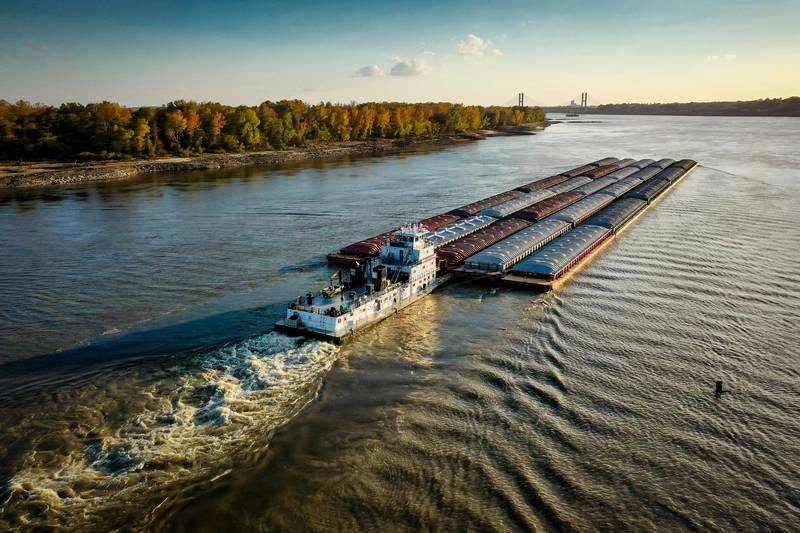 © Michael / Adobe Stock
© Michael / Adobe Stock
Looking back to last year, inland operators faced a great deal of challenges relating to the historic low water levels. What can and should be done to ensure smoother sailing in the future?
When I was down in Houston recently, we had a panel of Coast Guard and Corps and industry folks sharing their reflections on the experience of the 2022 low water. The absolute consensus was that despite the severity of the situation, we made out so much better in 2022 than we did in say 2012. Not only because of the really good communication structures that were in place, but also because the Corps took steps to improve the river through draining structures and things like that, removal of rock pinnacles. This was a Lower Miss rather than a Mid Miss situation. We had more nimble redeployment of dredges and buoy tenders. That's the kind of thing that we're going to need more of.
The ultimate solution there was we needed more rain, and eventually we got it. But with really close, good communication, and then anticipating that water levels rise and fall, we can keep commerce moving. We did keep commerce moving through that really significant situation last fall through nimble redeployment of assets. We have to keep that coming.
First of all, we have to make sure we have the assets: that the Corps has its dredges, that the Coast Guard has modern, efficient buoy tenders that are not always in the shipyard because they're breaking down, and that we're moving them where they need to be. All of those things can help prepare us for future eventualities.
One other thing I want to mention, because I feel like this was maybe not immediately focused on. The focus, was of course dredging the main channel, keeping that open, obviously critically important. A point failure was severe shoaling at ports and terminals. If I can't load the barge to nine and a half feet because the terminal won't allow me to load it past eight feet because it is desperately in need of dredging, then that's the limiting factor. So really making sure that we're able to pay attention to all parts of the system because they work together to keep traffic moving.
Looking at the West Coast, what's your take on the current CARB situation? From your point of view, what's the sensible solution going forward?
A state by state regulatory patchwork is not the right way to regulate an industry in interstate commerce. Unfortunately, we've seen that movie before, and it doesn't end well. Step one, I would say, no more CARBs. We don't want other states to follow this example. It is much more productive to really systematically, systemically look at infrastructure, funding and other improvements that facilitate adoption of greener technology.
We got what we got in California, so what should happen now? I think at a minimum we're going to need an extension of the compliance timeline, additional funding for engine repowers and a simple step: articulated tug, barge units are not harbor craft. They should not be regulated as harbor craft. They should be regulated like tankers in the at-berth rule. So those are three things that should happen now.
Do you think it's even possible for the industry to comply given the supply chain challenges, shipyard capacity, state of technology and other factors?
I think that the timeline is going to have to be changed. Unfortunately, a lot of these points were made during the rulemaking process and did not get the hearing that they needed. Unfortunately, we're going to now have an after-the-fact realization that some things are going to have to change. On the one hand, better late than never. On the other, that's just terrible from an investment predictability standpoint. When you're a vessel owner and you're going to be making investments in long life assets like vessels, engine technology, things that they take time to order, you need to plan shipyard periods for installation, crews need to be trained, we've got to have the shore site infrastructure, et cetera. It's just so much better to carefully think that all through and potentially have a longer timeline that is more realistic and better thought out, then we can plan for it and meet it.
That's what we did with Subchapter M. That's what we did with the phase out of single home vessels. We said, here's the goal, here's where we want to be. Let's develop a realistic timeline, and there aren’t going to be extensions. When you don't do that, then you find yourself saying, “Oh, we're going to need to issue an exemption or an extension here because this isn't available.” That's not the optimal way to do it. It's going to be the necessary way to do it if there aren't some regulatory changes made, but it's certainly not the best way to do it.
 © creativefamily / Adobe Stock
© creativefamily / Adobe Stock
Looking across the industry, what are some other important regulatory issues that AWO is currently paying attention to?
We mentioned some of the big ones in workforce and sustainability. I would be remiss if I didn't mention Subchapter M. It was a huge achievement on the part of vessel owners and mariners throughout our industry to meet the July 2022 100% COI deadline, really without a hitch as far as commerce is concerned. They worked hard, they spent a lot of money, they put in tremendous amounts of effort. There was no interruption of commerce. They got it done.
We’re not done with Subchapter M. There are going to be dry dock and internal structural exams, COI renewals every five years. It's going to be really important to have very good communication with the Coast Guard. Very good planning for shipyard periods, continued focus on the Coast Guard's part on consistent, practical interpretation, uniform enforcement as we move forward.
For AWO, as an organization, what is its top priorities for the coming six to 12 months and what's being done to address these?
Education, education, education of new members of Congress. We've got about 80 new members between the House and the Senate. There is so much to love about our industry in terms of security benefits, economic benefits, career opportunities, sustainability benefits. We have to tell that story. So job one is educating new policy makers, existing policy makers who find themselves in different jobs.
What is our message? Our message is rock solid support for the Jones Act. Our message is invest in and maintain our waterways infrastructure, work with us to attract, retain and develop the maritime workforce of the future. Let's work together to improve the sustainability of the transportation system by moving more cargo by water, by doing that more efficiently and by supporting companies in their efforts to improve their own environmental footprint.
I'm so optimistic about the relevance of our industry to our country's current and future challenges. Our commitment at AWO is really to advocate for them, to provide resources for members, to amplify their voice as they look to really support their customers and our country, and taking advantage of these new opportunities. We greatly value collaboration with public and private stakeholders, allies, coalition partners, to get that done because the issues are bigger than any one industry or organization.




